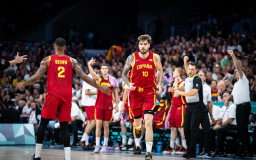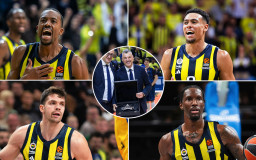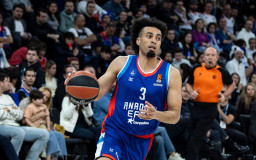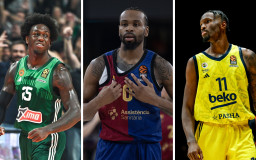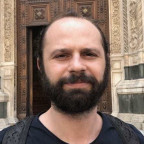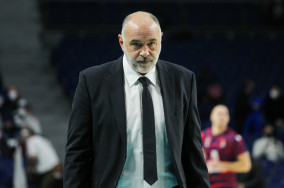It was the second game in the 2016 EuroLeague playoffs when Fenerbahce hosted Real Madrid, the defending champions, after winning Game 1.
I did not see everything perfectly because they put me in the 'sky lounge' of Ulkerspor Arena. The media tribune was just packed to full capacity. But I remember very well that it was the first time a guy called Luka Doncic played in the EuroLeague playoffs.
Zeljko Obradovic's Fenerbahce did not seem to blink for one second against the defending champions. Pablo Laso's Real Madrid was demolished 78-100 and eventually lost the series by being swept.
To check some initial responses after the game, I went downstairs, right in front of the Real Madrid locker room. Behind closed doors, Laso's voice was audible as he was talking furiously with his team. I waited for so long, but that speech did not come to an end.
That was not a bad season for neither Laso nor Real Madrid, as they won the Cup and the Spanish ACB title at the end. But you know how things work with Florentino Perez's Real: you snooze, and you lose the job.
I could not stop thinking, what if?
But when the series was ultimately finished in Madrid, Laso did not seem to be unhappy at all. Instead, he acknowledged what he achieved in the first five years of his term. The full-packed crowd of Real Madrid fans was not in the mood for protest. They were giving a standing ovation to their team after a brave fight.
"It is one of the greatest days in the history of Madrid basketball," Laso said that day.
As an ex-player of the club and a coach with no big CV, Pablo Laso was signed with a thick cloud of disbelief among the fans. They even protested in the first days and was presumed to be doomed for failure in a short span.
And in fact, he did not win the league or reach the Euroleague Final Four in the first season at the helm.
But how did Pablo Laso manage to turn the fans on his side? How did he keep doing his best and delivering success for such a long time in a club where winning is the only option? Don Pablo's tenure surely needs a closer look.
The Longevity
It is strange to think about that now, but how many people remember the coach before Pablo Laso at Real Madrid?
Well, it was Ettore Messina, and it was not a good stint at all. Back then, it was Xavi Pascual, and his pretty style of basketball imposed on Barcelona was ruling Spain and Europe.
Despite a big budget and an ambitious roster, Messina did not break the spell. During the Italian coach's 18 months tenure, Real Madrid played 109 games and won 76 of them (69.7%).
He used a total of 26 players, where he made 18 transactions. During those two seasons, Real Madrid were among the top spenders in the EuroLeague with 31 and 27 million euros spent.
Between 2001 and 2011, Real Madrid only grabbed three trophies (ACB in 2005 with Bozidar Maljkovic on the bench and Joan Plaza double in the ACB and the ULEB Cup in 2007).
In the same decade, the club had seven coaches and made 67 signings, of which 34 (50.7%) played for a season or less. From 2007 to 2012, no coach other than Joan Plaza could carry the Blancos to the ACB finals again.
Everything about this turmoil was about to change with Laso. A total of 21 trophies in 11 seasons. Now, that is something very, very hard to repeat.
From 2011 until this summer, Laso led Real Madrid with 646 wins in 847 games, the most in the club history. No one has ever, even the legendary Lolo Sainz (561 wins in 692) and Pedro Ferrandiz (409 wins in 477), succeeded in passing 800 games and/or winning that much.
Despite the high volume of the games, Laso maintained a 76% winning rate, third-best after the two club legends.
Besides, no one has ever worked for that long for Florentino Perez at the club. Not even Del Bosque, Carlo Ancelotti, Jose Mourinho, or Zinedine Zidane. Pablo Laso brought the biggest amount of trophies to him.
Interestingly, there were many times he was rumored to lose the job.
Remember the 2014 ACB finals where he had to leave the court with a wheelchair after being ejected from the court, and Real Madrid lost to Barcelona? It was also the season Real Madrid lost to Maccabi Tel Aviv in the EuroLeague final.
Until the Euroleague playoffs, Real Madrid lost only four games that season. Four out of 54! But yet, at the end of the season, Laso would learn that his assistants Hugo Lopez and Jota Cuspinera were not going to remain on the bench.
There is no clearer message given to a head coach other than that. Other names, like Fotis Katsikaris, appeared as a possible Laso's replacement at that time. It was the final warning.
Next season? Laso brought Real Madrid a historic triple crown, League-Cup-EuroLeague.
During his 11-year tenure, it was more or less the same story. There were many occurrences where both sides reached some crossroads. And each time, Laso not endured but answered with some more trophies or, at least, finals.
During last season, Real Madrid had a sort of crisis where they lost 8 games out of the last 9. During the process, one of the worst offensive stints was produced in the club's history. Unsurprisingly, some reports came into the circles on his possible sacking.
Did the story end there?
No, he just carried Real Madrid to another EuroLeague final. Supposedly, the final one in his term.
"I am not a coach that becomes too happy about victories and also too worried regarding the defeats," he noted after a tough loss against Fenerbahce Beko in Istanbul.
"Sometimes we can lose despite playing well. We lost two straight games, but we also had winning streaks. In this crazy calendar, we need to pass pages quickly and think about the next game."
That is one of the biggest achievements of Pablo Laso at Real Madrid. He could not beat Zeljko Obradovic's 13-year-long tenure at Panathinaikos, but he kept the top position on a bench for over a decade.
| Real Madrid head coach | Winning rate |
| Pedro Ferrandiz | 85% |
| Lolo Sainz | 81% |
| Pablo Laso | 76% |
| Joan Plaza | 71% |
| Ettore Messina | 69% |
| Zeljko Obradovic | 69% |
| George Karl | 69% |
| Sergio Scariolo | 66% |
| Bozidar Maljkovic | 59% |
| Julio Lamas | 59% |
The Game-Changing Acts
When Laso arrived on the Real Madrid bench, the club was desperate for success. From 1995 to 2011, Real Madrid won only 3 ACB titles, 1 Saporta Cup, and 1 ULEB Cup. That was all. They failed to lift the Copa Del Rey in 19 seasons from 1993.
The latter was about to change in less than a season when Real Madrid beat Barcelona in the Cup final. But some other things definitely took some time.
In 2011, Real were finally back in the Final Four with Messina but eventually lost to Maccabi by a big margin. Let alone the established foreigners in the head coaching position, the previous Spanish coaches did not leave very good memories.
Javier Imbroda failed to lead the team to the playoffs, and Joan Plaza did not resolve problems with the media and the club itself despite bringing them a ULEB Cup. Laso was just another Spanish coach at that time, with only 124 ACB games under his belt, with a balance of 49 wins and 75 losses (Gipuzkoa, San Sebastian).
In 2013, he led Real Madrid to the EuroLeague final in 18 years (after Obradovic's time). Los Blancos were leading 27-10 in the first half against Olympiacos, just to watch Spanoulis grabbing the trophy from their hands in the second half.
The following season, David Blatt's Maccabi did something similar, even in a more epic manner.
But with time, Laso figured out a winning formula, especially when it mattered the most. In 2015, they had a 23-5 record in the EuroLeague. Real did not waste home court advantage in the Final Four and completed the historic triple crown.
He just broke the spell of Barcelona in the domestic arena as well as Olympiacos' daunting dynasty attempt to win 3rd title in the last 4 seasons.
The Roster Management
One of Laso's specialties was finding a way to keep a dialogue with his players, no matter their age, role, and status.
This approach had many aspects, as he showed everyone fulfilling an impossible task brilliantly: Keeping a core group of veterans on the side, developing young players around them, and staying competitive at the top level.
Easy to say, but not so much to do. Besides, Laso also sharpened star power and made the most out of them but also utilized the role players in the ways that they enjoyed themselves and gave the maximum to help the team.
Before Laso, many deemed to pair Sergio Llull and Sergio Rodriguez on the court, but the Basque coach knew the potential.
"I spoke to him on the first day because I had seen him play as a point guard," Laso reflected on Llull.
"I said: Sergi, my idea is that you play as a point guard. I know you can adapt to various positions, but I think your growth at the highest level goes through this position."
Through all those long years, Felipe Reyes kept on with his leadership duties and became one of the most prominent on-court leaders. Andres Nocioni retired much earlier, but Laso knew he could count on the Argentinean to raise the team's tenacity and solidarity.
Sometimes it looked like he made the team overdependent on these players' form and decisions. Still, most of the time, Laso took the risk of disrupting the team's balance of power to make the most of these gifted players and convinced others that they were the ones to be relied upon. And his swat team, led by Llull himself, rarely disappointed.
"Madrid needed a coach like him," said Llull in an interview with El Confidencial. "He was a Madrid player, and he knew the club. He gives you a lot of confidence."
Another good example is Rudy Fernandez, who could have easily been a victim of ceding into mediocrity after his return from the NBA but transformed himself into a much more complete player on both sides of the court.
He lost some physical abilities after repetitive injuries, but Laso guided him to become much more effective in using his basketball IQ.
Jaycee Carroll arrived from Gran Canaria and, under Laso's mentorship, became Europe's catch&shoot and off-screen 3-point shooting guru. Dontaye Draper and Marcus Slaughter became pivotal for the defensive integrity in their respective positions.
"They are stars in my team. For me, a player is not a star because he scores 20 points. As a coach, there are star players who can leave the game with zero points. The important thing is to know what needs to be done for your team to win, and I aspire that all the players believe themselves as essential," Laso told AS.
Interestingly, most of his signings remained on the team for longer periods, while a few of them were cut after their first year (with the exceptions of Hettsheimeir, Ndour, Lima, Álex Suarez, Hunter, Randle, Klemen Prelpelic, or Jordan Mickey). He found peculiar ways to make things work.
Under his guidance, Jeffrey Taylor became a highly useful 3&D player with special lock-down assignments on the opponent's star guards. Gabriel Deck built on his strength and toughness and blended all his hard-nosed approach with a daunting offensive game on post-up playmaking.
Likewise, Anthony Randolph and Trey Thompson became truly instrumental bigs who can shoot from deep.
All these were good quality players, but Laso's schemes made them look even better. In a parallel universe, they could have easily fallen into oblivion.
Obviously, Laso had a special thing for working with guards and the youngsters. He was supportive but also demanding from them.
The prime example is Luka Doncic, who was given the jersey adamantly at the age of 16 to make him the third-youngest player to debut in the history of ACB (Angel Rebolo, 15 years old, Ricky Rubio, 14 years old).
"He's a great basketball player, and I wouldn't want to put him in the point guard or forward position," Laso told El Confidencial. "I think he can do many things, and he is a player still growing who can improve a lot. I hope he gives us a lot, as he has been doing for more than a year because he debuted in the playoffs two years ago. I'm still waiting for him to grow as a player, regardless of whether I play point guard, forward, or center."
You know the rest of the story.
But after Doncic, he somehow facilitated consistency in the same position. Facu Campazzo, mastering his craft elsewhere until then, earned his place as the starting point guard of the team. Despite inheriting a completely different skill set, the Argentinean magician became the next one to make his way to Euroleague greatness and jumped to the NBA level.
Matteo Spagnolo is a more recent example that Laso worked on previously. He is picked by the Timberwolves in the NBA Draft 2022 and currently playing in the Summer League.
Many people still lament Fabien Causeur's missed MVP award during Final Four in Belgrade 2018, but the Frenchmen's case remained peculiar.
There were many times that Laso was rumored to erase his name on the roster, but that never happened. Interestingly, Causeur not only outlived Laso in the roster but also came to the rescue of his coach at the most required yet, unexpected times.
The Final Four we just saw last May, is another good example.
We also should not overlook Usman Garuba, a major academy product. At the age of 19 and only 2nd major season with the seniors, Garuba almost hacked the 2020-21 playoffs series against Anadolu Efes after a heroic Game 4 with 24 points and 12 rebounds.
But Garuba's offensive exploits were just the tip of the iceberg as he was used in a very strategic role in a confusing zone defense in that series.
No one will ever forget that game where Real Madrid pulled off a historical win against CSKA with 5 academy players like Sadiq Garuba, Urban Klavzar, and Baba Miller.
We also remember Tristan Vukcevic playing some important minutes and roles during last and this season until he left for Partizan.
The Playing Style
We could suggest that Laso changed not only the fate of the club's basketball branch but also the playing style.
During Messina's term in 2009-2011, Real Madrid's game pace stats were below the EuroLeague average. The team had more of a defensive identity, as the offensive and the defensive rating suggest. That was not essentially a negative indicator because, for most of the time, winning basketball was the slow pace-low possession of basketball in Europe.
But that was about to change.
"There is no definite moment, but there is a basketball philosophy that you carry inside and try to transmit, added to the talent of your players," Laso explained his philosophy in the early days.
"When I saw Real Madrid last year, there were things I liked and others I didn't. I had a starting point, a philosophy of the game: I wanted an attractive and aggressive basketball and attack on the open court. But, when I assessed my squad, I made the biggest effort to use the players where they could offer the best performance."
In his first season at the helm, Laso set the tone with his preferred style of basketball. During his tenure, Real Madrid embraced a high tempo-high possession playing style with many quick shots.
Regarding the game pace, offensive ratings, and 3-point attempt rates, Real Madrid almost never fell behind the EuroLeague average, and, most of the time, the Spanish powerhouse was way above it.
In a sense, before Golden State Warriors came up with a lethal combination of winning basketball with a spectacular aspect, Pablo Laso's Real Madrid was trying something similar.
Establishing a direct link between the two basketball identities would be way too daring, but some shared characteristics like collective offensive effort flourished with pace and lots of 3s are undeniable.
That spectacular basketball brand changed the club's fortunes on the court and in the stands. The average number of spectators following the white team rose from 5,000 at the Caja Mágica to 11,000 at the Palacio de Goya.
Laso's way of creating shots offered an alternative approach to the European game. In an era of pick and roll, he imposed an off-ball scheme, with lots of movement, creating off-screen and catch and shoots.
We don't have the relevant figures prior to 2017-18 (due to lack of data), but in the last 5 years, Real Madrid were the absolute outliner regarding the shots created via flare screens or off-ball movements.
| Season | Off-screen shot frequency in all shots (Ranking in EuroLeague) | Off-screen shot accuracy | 3-point accuracy |
| 2017-18 | 13.2% (1st) | 48% (4th) | 38% (8th) |
| 2018-19 | 13.0% (1st) | 46% (5th) | 38% (7th) |
| 2019-20 | 15.0% (1st) | 51% (4th) | 38% (6th) |
| 2020-21 | 11.0% (2nd) | 42% (13th) | 36% (13th) |
| 2021-22 | 9.0% (3rd) | 44% (5th) | 35% (8th) |
I explained some specifics of this system elsewhere, and I don't want to choke up the article with those detailed "third man" options, etc.
But to make one thing clear, his schemes and style are made of unbreakable rules, cast of iron.
His father, Pepe Laso, once made it clear that Pablo doesn't 'force' his players to do what they don't know but instead motivates them to do what they know.
"What he tries to do is make the player who does one thing well do that thing. For example, Carroll has been told to shoot as many 3s as he wants," Pepe Laso said.
This was more of a collection of principles, where the players also had some space to express themselves and improvise in a clear-cut framework.
"He is a coach who lets play but also sets a lot of guidelines to read the game," said Sergio Rodriguez. "We build the confidence to be champions. The merit is not only the titles but also reaching those finals."
His game was not easy to adapt for the centers lacking the required intensity, shot, or mobility. Due to that, the turnover rate was the highest in this position among all: Ante Tomic, Mirza Begic, Willy Hernangómez, Salah Mejri, Rafa Hettsheimeir, Ioannis Bourousis, Augusto Lima, and Othello Hunter did not remain long.
But he also ripped some towering bigs to integrate his game flow, like Gustavo Ayon and Walter Tavares. Both became one of the most impactful centers in the last 10-15 years of the EuroLeague, defensively and offensively.
Last but not least, let's not forget that Real Madrid are not a team that was only made up of offensive prowess. Laso's ability to combine defensive intensity, ingenuity, and tenacity surprised and suffocated opponents most of the time.
Laso was never out of new ideas and his ability to think outside the box. The offensive showdown was a complementary wipe-out process in disguise.
"Our pace always comes from our defensive actions. Everyone talks about our attack, but we are a team that needs to hold on to the back," Laso clarified.
The pace for us is non-negotiable, we need it for the players we have, but to be able to have it, you have to be solid behind. Dominating the rebounds has also been key, in which there has been a wide difference between the two teams."
As they say, every good thing has to come to an end. Nothing is forever. But was it the time and right method to say goodbye to Laso? Real Madrid decided to part ways with him due to the medical advice of the club doctors. However, Laso did not seem to be content with this decision.
"Happy to share with everyone that I have full confirmation from the doctors, who have treated me that I can train any basketball club professionally," he tweeted.
Is this the last term of Laso at Real Madrid? Could we see another spell? Everything is possible in this crazy basketball universe. But one thing is certain: his shadow of glory and reliability will hang above his successors' heads for a long time. Like the sword of Damocles.
Like what we are doing? You can express your gratitude here.